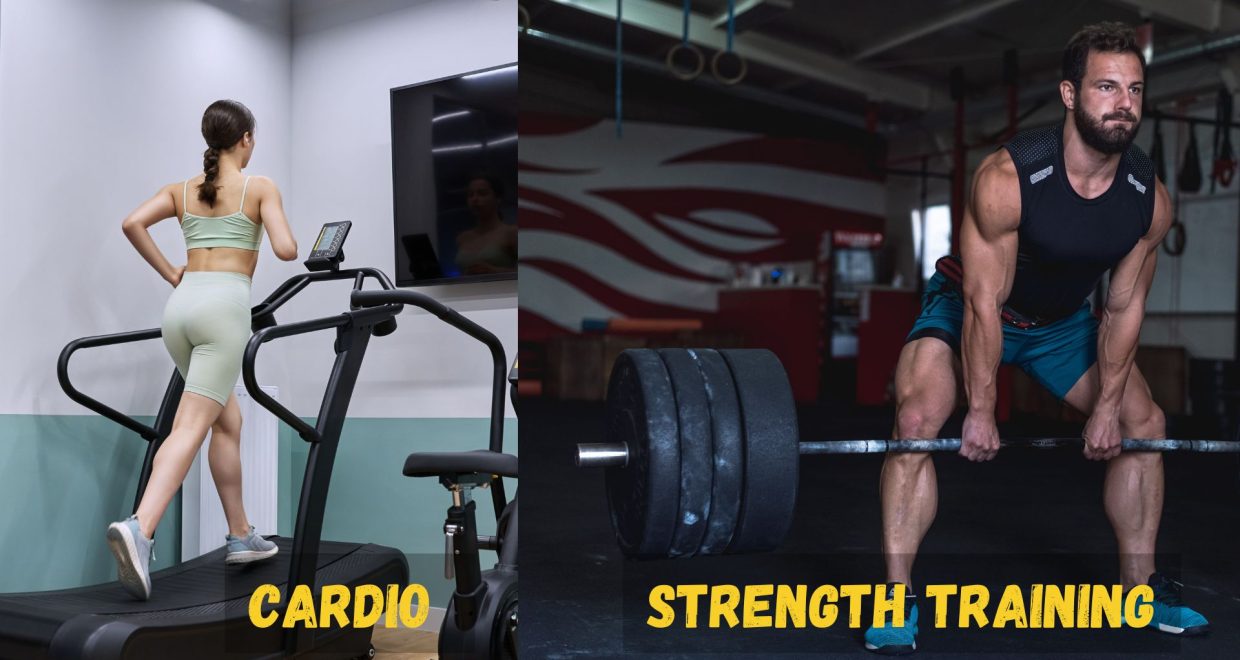When it comes to achieving fat loss, two primary types of exercise dominate the conversation: cardio and strength training. Both approaches have unique benefits and contribute to fat loss differently. But which method is more effective? To answer this question, we need to examine the science, benefits, and strategies for maximizing results.
Do follow nutrifit essentials for more updates and articles!
Understanding Fat Loss: The Basics
Fat loss is fundamentally about creating and maintaining a caloric deficit, where your body expends more calories than it consumes. This deficit forces the body to tap into stored energy reserves—primarily fat—to meet its energy demands. However, the process isn’t as simple as just eating less or exercising more. Several factors influence how efficiently the body burns fat, including metabolic rate, activity levels, diet composition, and exercise choices.
1. Caloric Expenditure: How Your Body Burns Calories
Your body burns calories through three main processes:
Basal Metabolic Rate (BMR):
- BMR accounts for the majority (60-75%) of daily calorie burn. It represents the energy your body uses to sustain basic functions like breathing, circulation, and cell repair.
- Factors affecting BMR include age, gender, genetics, and body composition. For instance, muscle tissue burns more calories at rest compared to fat tissue, making muscle mass a key determinant of BMR.
Physical Activity:
- This includes all movement, from structured exercise to daily tasks like walking or climbing stairs. Physical activity is the most variable component of caloric expenditure and can contribute significantly to overall calorie burn.
- The intensity, duration, and type of activity (e.g., cardio vs. strength training) influence how many calories are burned.
Thermic Effect of Food (TEF):
- TEF refers to the energy required for digestion, absorption, and processing of nutrients. It accounts for about 10% of daily calorie burn.
- Protein has the highest thermic effect, requiring more energy to metabolize than carbohydrates or fats.
Together, these components determine your Total Daily Energy Expenditure (TDEE), the total number of calories your body uses in a day. To lose fat, your caloric intake must be consistently lower than your TDEE.
2. The Role of Dietary Intake in Fat Loss
While exercise is important, diet plays the most significant role in fat loss. A well-balanced diet ensures that your body has the nutrients it needs to function optimally while maintaining a caloric deficit.
Key dietary principles for fat loss include:
Caloric Awareness:
- Tracking food intake helps ensure you’re in a caloric deficit. Apps, food diaries, or portion control methods can aid in monitoring consumption.
Nutrient-Dense Foods:
- Emphasize whole, unprocessed foods like vegetables, fruits, lean proteins, whole grains, and healthy fats. These foods are lower in calories but higher in vitamins, minerals, and fiber, promoting satiety and reducing the likelihood of overeating.
Protein Intake:
- Protein is particularly important for fat loss as it preserves muscle mass during a caloric deficit. It also has a high thermic effect, which boosts metabolism slightly.
- Aim for 1.2–2.2 grams of protein per kilogram of body weight per day, depending on activity level and goals.
Timing and Distribution:
- While the total caloric intake is most important, distributing meals evenly throughout the day can help stabilize blood sugar levels and reduce hunger.
Hydration:
- Staying hydrated supports metabolic processes and can help control appetite, as thirst is sometimes mistaken for hunger.
3. The Influence of Exercise on Fat Loss
While diet establishes the foundation for fat loss, exercise amplifies and sustains the process. It contributes to fat loss by increasing caloric expenditure, preserving muscle mass, and improving overall health.
Cardiovascular Exercise (Cardio):
- Cardio is effective for burning calories in the moment, especially during moderate to high-intensity sessions.
- It enhances cardiovascular health and stamina, making daily activities easier and more energy-efficient.
Strength Training:
- Unlike cardio, strength training’s impact on fat loss is indirect but profound. It builds and preserves muscle mass, which increases BMR and promotes long-term fat burning.
- The afterburn effect (Excess Post-Exercise Oxygen Consumption, or EPOC) means you continue to burn calories after a strength training session as your body repairs and rebuilds muscle tissue.
Combination of Cardio and Strength:
- Combining these forms of exercise offers the best of both worlds: immediate calorie burning through cardio and long-term metabolic enhancement through strength training.
4. The Importance of Exercise Type and Intensity
Different forms of exercise affect the body in unique ways, making it important to choose a routine that aligns with your goals.
- Cardio for Immediate Calorie Burn: Ideal for those who want to create a large caloric deficit quickly.
- Strength Training for Muscle Preservation: Essential during fat loss to ensure the weight lost comes from fat rather than lean tissue.
- High-Intensity Interval Training (HIIT): Combines cardio and strength elements for efficient calorie burn and muscle engagement in a short amount of time.
5. Long-Term Benefits of Combining Diet and Exercise
While creating a caloric deficit is the primary driver of fat loss, combining diet with structured exercise offers numerous advantages:
- Sustainable Results: Exercise helps prevent plateaus by maintaining muscle mass and increasing calorie expenditure.
- Improved Body Composition: Strength training reshapes the body by promoting muscle growth, ensuring fat loss doesn’t result in a “skinny fat” appearance.
- Metabolic Health: Regular physical activity improves insulin sensitivity, lowers blood pressure, and supports cardiovascular health.
- Mental Well-Being: Exercise reduces stress, enhances mood, and improves sleep, all of which contribute to better adherence to fat loss goals.

What Is Cardio?
Cardio, or cardiovascular exercise, encompasses any form of rhythmic, repetitive activity that raises your heart rate and breathing to sustain elevated physical effort. The primary goal of cardio is to enhance the efficiency of your cardiovascular system, which includes your heart, lungs, and blood vessels. By improving how these systems work together, cardio exercises ensure better oxygen and nutrient delivery throughout the body. Popular forms of cardio include running, cycling, swimming, rowing, and aerobic dance routines. Each of these activities involves continuous motion, making them excellent for building endurance and burning calories.
The adaptability of cardio exercises is one of their most appealing aspects. They can be performed at various intensity levels, making them accessible to beginners, intermediate fitness enthusiasts, and athletes alike. Additionally, cardio does not necessarily require expensive equipment or gym memberships; simple activities like brisk walking or climbing stairs also qualify as effective cardiovascular workouts.

The Mechanism Behind Cardio
The science of cardio lies in its ability to elevate the heart rate to specific zones, depending on the activity’s intensity. When you perform cardio, your body primarily relies on aerobic metabolism—a process that uses oxygen to convert carbohydrates and fats into usable energy. This is why you might feel your breathing become deeper and faster during cardio sessions; your body is working harder to meet the increased oxygen demand.
Over time, regular cardio strengthens the heart muscle, enabling it to pump blood more efficiently with each beat. This adaptation reduces your resting heart rate and enhances your body’s ability to deliver oxygen to muscles during exertion. As a result, you’ll experience improved stamina, better physical performance, and overall vitality.
The Immediate Benefits of Cardio: Burning Calories
One of the most well-known advantages of cardio is its capacity for immediate calorie burning. The number of calories burned depends on factors such as the type of activity, intensity, duration, and individual characteristics like body weight. For instance, a vigorous 30-minute session of running can burn significantly more calories than a leisurely walk of the same length. This makes cardio an invaluable tool for those looking to create a caloric deficit—a critical component of fat loss.
Additionally, high-intensity cardio activities like sprinting or cycling at a challenging pace elevate calorie burn per minute, offering time-efficient workouts for those with busy schedules. Even lower-intensity cardio, like walking or light jogging, contributes to fat loss over longer periods.
Long-Term Benefits: Improved Cardiovascular Health
Beyond immediate calorie burn, cardio offers profound long-term benefits for heart health. Regular engagement in cardiovascular exercise strengthens the heart muscle, making it more efficient at pumping blood. Over time, this improvement reduces resting heart rate and lowers blood pressure, significantly decreasing the risk of heart-related conditions such as hypertension, stroke, and coronary artery disease.
Cardio also has a favorable impact on blood lipid profiles, increasing levels of high-density lipoprotein (HDL, or “good” cholesterol) while reducing low-density lipoprotein (LDL, or “bad” cholesterol). These changes contribute to better arterial health and improved circulation, reducing the likelihood of plaque buildup that can lead to cardiovascular issues.
For individuals with diabetes or prediabetes, cardio is particularly beneficial. It enhances insulin sensitivity, allowing cells to better absorb glucose from the bloodstream, and helps regulate blood sugar levels over time.
Cardio and Weight Management
Incorporating cardio into your routine is a proven strategy for managing weight effectively. By increasing daily energy expenditure, cardio helps establish or maintain a caloric deficit, which is essential for fat loss. This makes it especially valuable for individuals with sedentary lifestyles who struggle to burn sufficient calories through daily activities alone.
Cardio also supports long-term weight management by preventing fat regain. When paired with a balanced diet, regular cardio helps sustain a healthy weight and prevents the gradual weight gain often associated with aging or reduced physical activity.
Moreover, cardio promotes changes in body composition. While it may not build significant muscle mass compared to strength training, it can help reduce overall fat levels, leading to a leaner, healthier appearance.
Types of Cardio: LISS vs. HIIT
Cardio workouts can be categorized into two main types based on intensity: Low-Intensity Steady State (LISS) and High-Intensity Interval Training (HIIT).
Low-Intensity Steady State (LISS):
LISS involves performing a consistent activity, like brisk walking or light jogging, at a low-to-moderate intensity for an extended duration. This type of cardio is accessible, low-impact, and easier on the joints, making it an ideal option for beginners or those recovering from injuries. While the calorie burn during LISS may be slower compared to HIIT, its sustainability over longer periods makes it a reliable choice for steady fat loss.
High-Intensity Interval Training (HIIT):
HIIT alternates between short bursts of intense effort and recovery periods. For instance, sprinting for 30 seconds followed by walking for a minute is a classic HIIT structure. This approach maximizes calorie burn within a shorter timeframe and triggers the “afterburn effect” or Excess Post-Exercise Oxygen Consumption (EPOC). This means your body continues to burn calories at an elevated rate even after the workout ends. HIIT also improves both aerobic and anaerobic fitness, making it an excellent option for those looking to enhance performance and save time.
Mental Health and Emotional Benefits of Cardio
The advantages of cardio aren’t limited to physical health. Engaging in regular cardiovascular exercise significantly boosts mental well-being. During cardio, your brain releases endorphins—natural chemicals that create feelings of happiness and reduce stress. This is why cardio is often recommended as a natural remedy for anxiety and depression.
Additionally, cardio promotes better sleep quality, sharpens cognitive function, and enhances memory. These psychological benefits, combined with the physical improvements, contribute to an overall sense of well-being, making cardio a holistic health tool.
Balancing Cardio with Other Fitness Goals
While cardio offers numerous benefits, it’s important to balance it with other types of exercise, especially strength training. Over-reliance on cardio alone may lead to muscle loss or plateauing results, particularly if dietary protein intake is insufficient. Combining cardio with resistance training ensures not only fat loss but also muscle preservation and improved metabolic health.
By incorporating both LISS and HIIT into your fitness plan, you can enjoy the diverse benefits of cardio while preventing monotony and optimizing overall health outcomes. Cardio remains a cornerstone of fitness, adaptable to individual goals and lifestyles.
What Is Strength Training?
Strength training, also known as resistance or weight training, focuses on exercises designed to build and maintain muscle mass while improving overall strength. This type of training involves using resistance to stimulate muscle fibers, prompting growth and adaptation. Resistance can come in various forms, including free weights like dumbbells and barbells, machines, resistance bands, or even your own body weight through exercises like push-ups, planks, and squats.
Strength training is not just for bodybuilders or athletes; it’s a fundamental component of any fitness regimen for individuals seeking to improve health, aesthetics, or athletic performance. It helps reshape the body, making it leaner and more defined, while also improving functional abilities like lifting, pushing, or pulling.

The Benefits of Strength Training
Strength training offers a multitude of benefits that extend beyond physical appearance.
1. Muscle Preservation During Fat Loss
When in a caloric deficit—a state necessary for fat loss—your body doesn’t exclusively burn fat for energy. Without adequate muscle stimulus, it may also break down muscle tissue. Strength training provides the necessary stimulus to prevent muscle loss, ensuring that the majority of weight lost comes from fat stores rather than lean tissue.
2. Boosting Resting Metabolic Rate (RMR)
Muscle tissue is metabolically active, meaning it burns more calories at rest compared to fat tissue. For every pound of muscle you gain, your body’s resting metabolic rate increases, allowing you to burn more calories throughout the day. This is especially beneficial for individuals aiming for long-term fat loss or maintenance.
3. The Afterburn Effect (EPOC)
Strength training triggers excess post-exercise oxygen consumption (EPOC), a process where your body continues to burn calories even after your workout has ended. This afterburn effect can last up to 24–48 hours as your body repairs and rebuilds muscle tissue. The more intense your workout, the greater the EPOC, making strength training a time-efficient way to enhance calorie burn.
4. Improved Functional Strength
Strength training improves the performance of daily tasks by increasing functional strength and stability. Activities like lifting groceries, climbing stairs, or playing sports become easier. Additionally, it strengthens bones and connective tissues, reducing the risk of injuries and conditions like osteoporosis.
5. Enhanced Body Composition
While cardio primarily reduces fat, strength training builds and preserves muscle, leading to a leaner, more toned appearance. It ensures that fat loss doesn’t result in a “skinny fat” look, where the body appears thin but lacks muscle definition.
Types of Strength Training
Strength training encompasses a wide variety of methods and modalities, each suited to different goals and experience levels.
1. Hypertrophy Training
Hypertrophy training focuses on muscle growth by performing moderate weights and higher repetitions, typically in the range of 8–12 reps per set. This approach is ideal for individuals looking to enhance muscle size and improve overall body composition.
2. Powerlifting and Heavy Lifting
This type involves lifting heavy weights with low repetitions, usually 1–5 reps per set. It’s geared toward building maximum strength and power rather than muscle size. Exercises like the bench press, deadlift, and squat are staples of powerlifting.
3. Circuit Training
Circuit training combines strength and endurance by performing multiple exercises in a sequence with little to no rest in between. This method is efficient for burning calories while building strength, making it an excellent choice for time-constrained individuals.
4. Bodyweight Training
Bodyweight exercises like push-ups, lunges, and planks use your own weight as resistance. This form of training is accessible, requiring no equipment, and is effective for beginners or those exercising at home.
How Strength Training Supports Fat Loss
Strength training is a powerful tool for fat loss because it focuses on improving body composition rather than simply reducing weight on the scale. The benefits extend far beyond immediate calorie burning:
1. Metabolic Adaptations
As muscle mass increases, your body’s ability to burn calories also rises. Muscle tissue requires more energy for maintenance compared to fat, which means your total daily energy expenditure (TDEE) naturally increases.
2. Fat Distribution
Strength training specifically targets visceral fat, the fat stored around internal organs that is associated with higher health risks. Regular resistance exercise helps redistribute fat stores, reducing visceral fat while preserving lean mass.
3. Prevention of Metabolic Slowdown
During prolonged periods of dieting, the body often adapts by reducing its metabolic rate, making further fat loss more challenging. Strength training combats this by preserving or increasing muscle mass, which prevents significant metabolic decline.
The Role of Progressive Overload
Progressive overload is a cornerstone principle of strength training, requiring gradual increases in resistance or intensity to stimulate muscle growth and adaptation. This can be achieved by:
- Increasing the weight lifted
- Performing additional repetitions or sets
- Reducing rest intervals between sets
By consistently challenging your muscles, you ensure continuous progress in strength and body composition.
Strength Training vs. Cardio for Fat Loss
Fat loss is not solely about shedding weight on the scale but about improving body composition and overall health. When comparing strength training and cardio, each exercise type offers unique benefits, but combining the two is often the most effective strategy for optimal fat loss and body transformation. Understanding the distinct roles of strength training and cardio helps you tailor a fitness plan to achieve long-term results.

Calorie Burn: Immediate vs. Sustained
Cardio is often celebrated for its ability to burn a significant number of calories in a single session. Activities like running, cycling, or swimming can burn 300–400 calories in just 30 minutes, depending on the intensity and individual factors like weight and fitness level. In contrast, strength training typically burns fewer calories during the workout itself, with a 30-minute session averaging around 150–250 calories.
However, the story doesn’t end when the workout is over. Strength training offers the unique benefit of excess post-exercise oxygen consumption (EPOC), often referred to as the “afterburn effect.” This phenomenon occurs as your body repairs muscle tissue and replenishes energy stores after a strength training session, leading to increased calorie burn for up to 24–48 hours post-workout. While cardio also produces EPOC, its effects are generally shorter and less pronounced compared to strength training.
Moreover, strength training contributes to muscle mass maintenance and growth, which has a profound impact on your metabolism. Muscle tissue is metabolically active, meaning it requires more energy to sustain than fat tissue. As a result, the more muscle you build, the higher your resting metabolic rate (RMR), leading to greater daily calorie expenditure even at rest. This metabolic boost makes strength training a powerful tool for sustained fat loss over time.
Body Composition: Shaping the Lean and Toned Physique
While both cardio and strength training aid in fat loss, their impact on body composition differs significantly. Cardio primarily focuses on burning calories, which can lead to a reduction in both fat and muscle tissue if not complemented by resistance training. This can result in a “smaller” version of your current body, often lacking muscle definition and tone.
Strength training, on the other hand, targets muscle retention and growth while promoting fat loss. By incorporating resistance exercises, you not only reduce fat but also build lean muscle, creating a more toned and sculpted appearance. This transformation is crucial for avoiding the “skinny fat” look—a condition where an individual appears thin but has a higher percentage of body fat relative to muscle.
Key Advantages of Strength Training for Body Composition:
- Muscle Preservation During Fat Loss: When in a caloric deficit, strength training signals your body to retain muscle tissue, ensuring that weight loss primarily comes from fat.
- Improved Fat Distribution: Resistance training helps target and reduce visceral fat, the harmful fat stored around internal organs, while maintaining or increasing subcutaneous muscle mass.
- Functional Aesthetics: Beyond aesthetics, increased muscle mass enhances physical performance, balance, and posture, contributing to a healthier and more capable body.
In contrast, excessive cardio without strength training can sometimes lead to muscle loss, especially when paired with insufficient protein intake or inadequate caloric consumption. This can slow your metabolism over time, making it harder to maintain fat loss.
Longevity of Results: Sustainable Fat Loss
Cardio is excellent for creating a caloric deficit quickly, making it an effective tool for those seeking immediate fat loss. However, its benefits plateau if it is not paired with other fitness strategies. Strength training, while slower in immediate calorie burn, provides a sustainable approach to fat loss by increasing muscle mass and boosting metabolism. Over time, this leads to a compounding effect where your body becomes more efficient at burning calories, even during rest.
Cardio for Short-Term Fat Loss:
- Burns a high number of calories per session, making it ideal for rapid calorie deficits.
- Effective for beginners who are not yet ready for more demanding strength-based exercises.
Strength Training for Long-Term Fat Loss:
- Builds a foundation of muscle that supports a higher metabolic rate.
- Ensures weight loss is sustainable by preserving lean body mass and preventing metabolic slowdown.
By combining the two, you benefit from the immediate calorie-burning effects of cardio and the long-term metabolic advantages of strength training.
Understanding Their Synergy
Strength training and cardio are not mutually exclusive; they complement each other in a well-rounded fitness plan. When combined, they provide a holistic approach to fat loss, ensuring that you not only lose weight but also enhance your overall health, fitness, and body composition.
How to Combine Strength Training and Cardio for Fat Loss:
- Alternate Workout Days: Dedicate specific days to strength training and cardio to ensure proper recovery for both.
- Incorporate HIIT: High-Intensity Interval Training (HIIT) blends the benefits of both cardio and strength, offering efficient calorie burn while engaging muscles.
- Active Recovery: Use light cardio, such as walking or cycling, on recovery days to promote blood flow and aid muscle recovery.
For example:
- Monday: Full-body strength training
- Tuesday: Moderate-intensity cardio
- Wednesday: Rest or active recovery
- Thursday: Upper-body strength training
- Friday: HIIT session
- Saturday: Lower-body strength training
- Sunday: Light cardio or yoga
This balanced approach ensures that you reap the benefits of both exercise modalities without overtraining or risking burnout
Personalization and Preferences
Ultimately, the choice between strength training and cardio—or the decision to combine them—depends on individual preferences, goals, and lifestyle. Some people enjoy the meditative rhythm of a long run, while others thrive on the challenge of lifting heavy weights. Adhering to an exercise routine you genuinely enjoy increases the likelihood of consistency, which is the most important factor for success in fat loss.
For those with time constraints, HIIT can be an excellent option, offering a blend of strength and cardio benefits in a short amount of time. Alternatively, beginners might start with cardio to build a base level of fitness before incorporating strength training into their routine.
Conclusion
Strength training and cardio each have distinct roles in a fat loss journey. While cardio excels in immediate calorie burning and cardiovascular health, strength training reshapes your body by building and preserving muscle, boosting metabolism, and promoting sustainable fat loss. Together, they create a comprehensive strategy that targets fat loss from multiple angles.
By understanding the unique advantages of each and incorporating both into your fitness routine, you can achieve a leaner, stronger, and healthier body while ensuring long-term success. Whether you prioritize one over the other or combine them strategically, the key is consistency, personalization, and a focus on overall health and well-being.

